European Green Crab (Carcinus maenas)
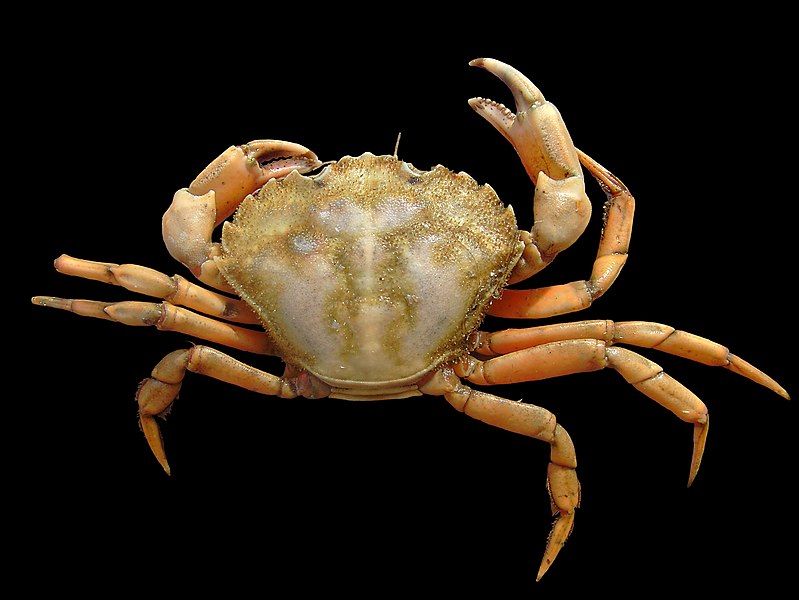
European green crab
Image credit: Hans Hillewaert
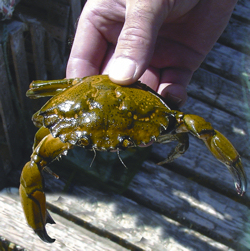
European green crab
Image credit DFO
Other common names: Green shore crab
French name: Crabe vert
Order: Decapoda
Family: Carcinidae
Did you know? Adult European green crabs are extremely hardy and can survive out of water for over five days! This makes them easier to be inadvertently transported by motorboat or in shipping cargo.
European green crabs are small marine crustaceans native to Europe and Northern Africa. They arrived to North America in the 1800’s by travelling in the ballast water of large shipping vessels.
There are now invasive populations of European green crab established on both the East and West Coast of Canada. Their long-distance spread is largely attributed to human activity through increases in the use of live bait, recreational boating, and pet release. They threaten coastal ecosystems by destroying eelgrass and shellfish beds, outcompeting native crab species, and through preying on native species. Economically they pose a threat to shellfish and fishing industries.
A hardy species, adult European green crab can survive several days on land and its free-floating larvae can survive long periods of time in standing water, such as ballast water or in live wells on recreational boats.
Learning to identify the European green crab is important to prevent accidental release and reporting suspected sightings.
European green crab is a small crab species that grows between 8-10 cm wide and varies in colour from olive green to brown or yellow. The crab’s joints are typically orange.

This invasive crustacean has several identifying features:
Shell shape – The shell has a distinctive diamond or triangular shape and has sometimes been described as a pentagon.
Marginal teeth on the shell – Its shell has five distinctive marginal teeth on either side of the crab’s crescent shaped eyes. These teeth are the best way to identify a European green crab and can easily be located and counted.
Legs – The crab’s legs are long compared to its body. The tips of the back legs are hairy, pointed and slightly flattened.
Claws – The claws are long, not rounded and differ in size.
Behaviour – European green crabs are aggressive and territorial.
Native Look-a-likes
Many native species in Atlantic Canada may appear similar to the European green crab. These include:
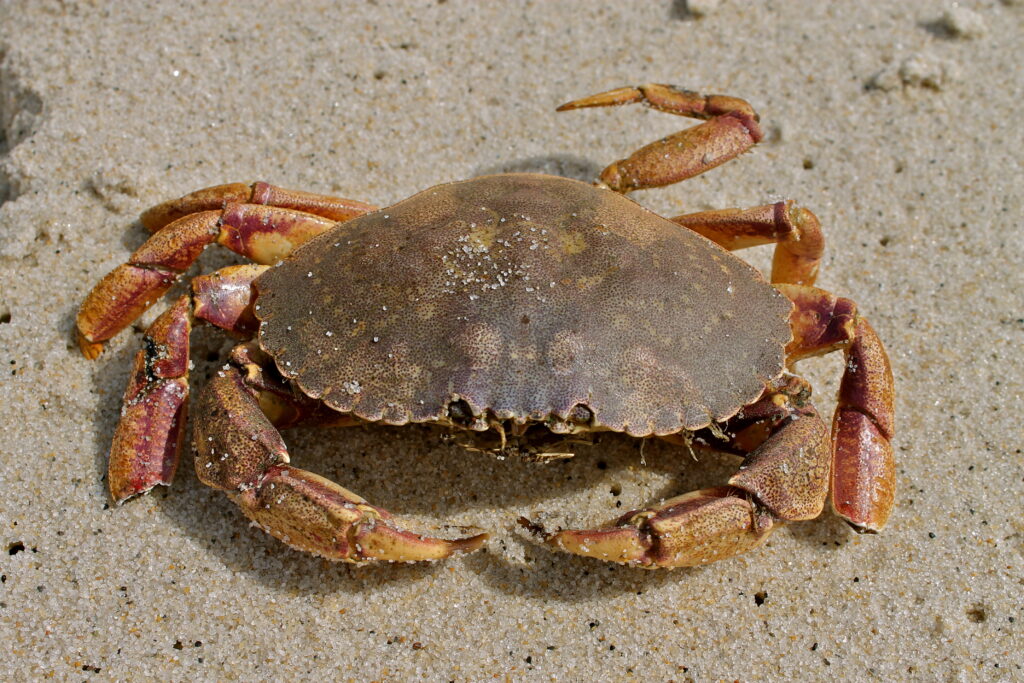
Jonah Crab (Cancer borealis), which…
- is larger than the European green crab (up to eighteen centimetres)
- has a scallop-shaped shell
- has nine rounded lobes on either side of its eyes
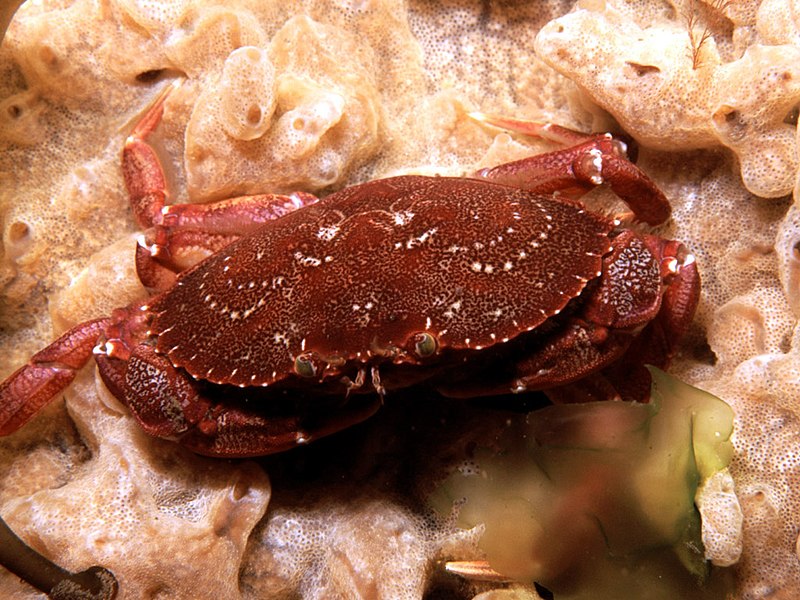
Rock Crab (Cancer irroratus), which…
- is larger than the European green crab (growing up to fifteen centimeters)
- have oval shaped shells
- have shells with nine rounded lobes on either side of their eyes
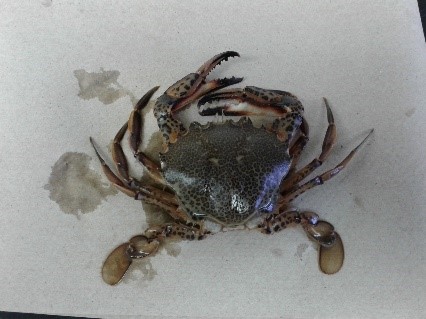
Lady Crab (Ovalipes ocellatus), which…
- has oval tips on its hind legs
- has five spines on either side of the eyes, like the European green crab
- is white to yellow/grey, with red/purple spots
The European green crab can live up to 4-7 years and reproduce up to two times a year. A single female can release up to 185,000 eggs each time they reproduce.
The seasonal timing of the European green crab life cycle varies between regions. Mating takes places when the females have molted. Males deposit spermatophores, containing sperm, into paired organs in the female called copulatory pouches. This sperm can remain viable for over four months.
Once fertilized, the female carries the eggs on her swimmerets for several months until they hatch.
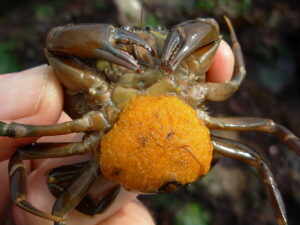
The eggs hatch into free floating plankton larvae and drift with the ocean currents for up to 80 days. This long larval phase can survive for extended periods in ballast water tanks, making it suspectable to spread through commercial fishing.
After about 80 days, larvae undergo final molting into juvenile crabs which measure about 2 mm wide.
Once they reach sexual maturity, European green crabs measure about 8-10 cm in diameter.
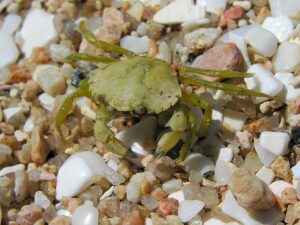
European green crabs are found in near-shore habitats, usually in shallow water at a depth of less than 6 meters. They prefer sheltered areas and bottoms that are sandy, muddy or pebbly and contain vegetation, including eelgrass beds.
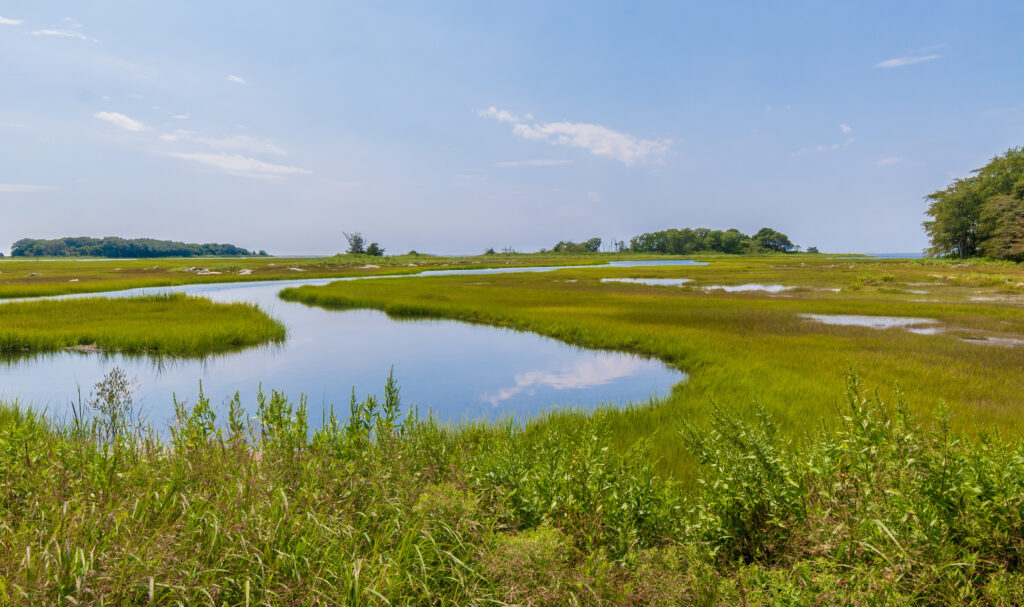
They can tolerate a wide range of water temperatures and salinities and therefore can be found in a variety of environments such as salt marshes, sandy beaches, and rocky coasts.
European green crabs have invasive ranges along both the East and West Coasts of North America. They are native to Europe and North Africa and likely arrived in North America around 1817 carried in the holds of wooden ships.
In Canada the European green crab has documented invasive populations in the following locations:
The East Coast:
- New Brunswick since 1951
- Nova Scotia since 1953
- The Gulf of St. Lawrence since 1994
- Prince Edward Island since 1997
- The Magdalen Islands, Québec since 2004
- Newfoundland and Labrador since 2007
The West Coast:
- British Columbia since 1998
- Within British Columbia, established populations of the European green crab can be found on the west coast of Vancouver Island.
Newer detections of European green crab since 2018 include:
- northern Vancouver Island (Port Hardy)
- southern Vancouver Island (Esquimalt Lagoon, Witty’s Lagoon)
- the Gulf Islands (Salt Spring Island)
- Haida Gwaii
- Southern British Columbian waters (Boundary Bay), just south of Metro Vancouver
Cold tolerance in Eastern Populations
Two distinct populations of European green crab are present in Eastern Canada which are notably different in their cold tolerance.
- The first population, which established in the 1950s, is not cold tolerant
- The second population, which established in the 1980s, originated from Northern Europe is better suited to survive colder northern waters
- The populations have since mixed, creating a hybrid that is cold tolerant and present in both north and south Atlantic Canada
Ecological
The European green crab is a highly resilient species and with no natural predators in their invasive range. They are able to invade and disrupt marine environments and biodiversity in a number of ways.
Destruction of Eelgrass Beds
In both Atlantic Canada and on the Pacific coast, European green crab threatens native eel-grass. Chopping off the shoots right at the base, the crab can easily destroy an entire bed. Eel-grass provides vital habitat to many types of fauna including marine invertebrates like crabs, waterfowl, seabird and juvenile fish species such as Pacific herring and Pacific salmon. Destruction of this critical habitat can negatively impact native wildlife.
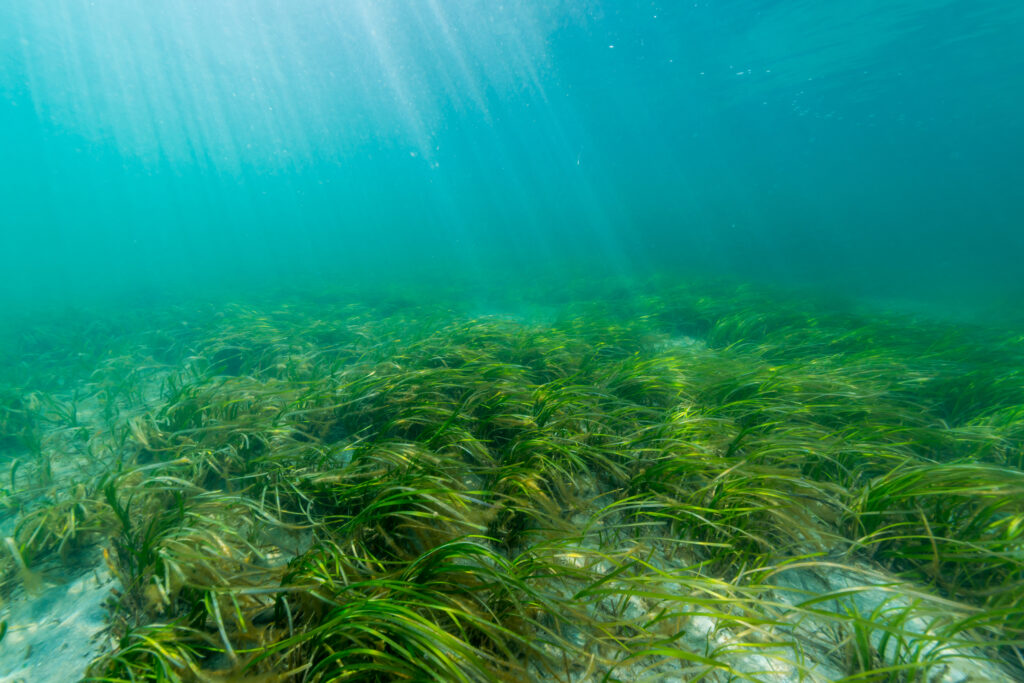
Other impacts
- European green crabs outcompete native crab species leading to loss of biodiversity
- Destruction of shellfish beds
- Over predation on native species including clams, oysters, mussels, and juvenile crabs, fish and lobsters
- Increased erosion of salt marshes when European green crabs mine for invertebrate prey
Social/Economic
European green crabs are detrimental to aquaculture on both the East and West coasts by:
- Damaging eels when they enter traps, reducing useable stock for eel fisheries
- Threatening commercially harvested lobster on Canada’s East Coast where they have been known to prey on juvenile and trapped adult American Lobster (Homarus americanus)
- Reducing the abundance of commercially harvested species such as fish and other crabs
- Spreading pathogens to other crustaceans, including lobsters, which are a commercially valuable species in Eastern Canada
Regulations and Prevention
European green crab larva and adults tend to rely on different methods of dispersal when invading new areas. The free-floating larva can be spread through standing water on boats or other water-based equipment while the hardy adults can be spread as stowaways on boats or through release into the wild as leftover bait or unwanted pets.
In Canada, saltwater species such as the European green crab are regulated federally. The European green crab is a controlled species under Federal Aquatic Invasive Species Regulations. This makes them subject to control when fishing and boating, and in areas where they are not native (which for European green crab includes all of Canada).
Ballast Water Regulations
Large vessels, such as shipping vessels, use ballast water to control their weight and ensure the stability of the ship. Unfortunately, when ballast water is taken in from one location and deposited into another, it can become a vector for the spread of invasive species.
European green crab larvae can survive for extended periods in ballast water tanks making this a potential pathway of spread. In Canada, the management of ballast water is controlled and regulated under The Canada Shipping Act. Ballast water regulation is critical in preventing the arrival of aquatic invasive species via shipping and trade.
Clean, Drain, Dry
Recreational watercraft, including motorboats, kayaks, and related equipment such as trailers, can carry and spread invasive aquatic species. The free-floating larvae of European green crab might be present in standing water in live wells, bilge water or other compartments. If these are not properly drained and dried, the larvae can be spread to other locations where they can establish new invasive populations.
Recreational boaters can prevent the spread of aquatic invasive species with three easy steps:
Step 1: Clean your boat from top to bottom by removing debris including plants and mud and wiping it down. Rinsing with hot or pressurized water is an additional precaution that will further prevent aquatic invasive species (AIS) spread when feasible.
Step 2: Drain all water from your boat by opening and removing all drain plugs and ensuring there is no water left in the seating area or any other compartments.
Step 3: Dry your boat from top to bottom with a towel. Leaving your boat to dry in the sun will help reduce the chance of moving AIS between waterbodies.
Learn more about recreational boating and aquatic invasive species here.
Bait and pet release
In many places, European green crabs can be purchased online for use as fishing bait or even as pets.
Anglers often enjoy using live bait while fishing, but improper disposal can lead to a new invasion. It is therefore important to avoid releasing bait into the natural environment where it can cause harm. Extra care should be taken with the European green crab as this is an aquatic species which has the ability to survive on land for extended periods of time and may pose a threat even if dumped away from a waterbody.
Pet release is another major vector of spread for aquatic invasive species. Owning a pet can be a great joy, but if you can no longer take care of your pet be sure to find it a new home and don’t let it lose. Pets released into the environment can have numerous negative consequences on ecosystem health and biodiversity if they persist and become invasive.
Learn more about the spread of invasive species through pet release here.
Report sightings
Reporting a sighting is a great way to help prevent the spread and reduce negative impacts of invasive species.
If you find a European green crab, it is recommended that you:
- Take photos
- Note:
- the exact location (GPS coordinates)
- the observation date
- identifying features
- Contact the Department of Fisheries and Oceans to report it
If you are confident in your identification and believe that you have caught a European green crab, please do not release it back into the environment.
Contact information for the Department of Fisheries and Oceans by province:
Visit the contact page for the most up to date information by province here.
British Columbia:
Toll-free: 1-888-356-7525
Email: AISPACIFIC@dfo-mpo.gc.ca
New Brunswick
Toll-free: 1-866-759-6600
Email: DFO.GulfAquaticInvaders-EnvahisseursaquatiquesduGolfe.MPO@dfo-mpo.gc.ca
Newfoundland and Labrador
Toll-free: 1-855-862-1815
Email: DFO.NLAIS-EAETNL.MPO@dfo-mpo.gc.ca
Nova Scotia (Gulf)
Toll-free: 1-866-759-6600
Email: DFO.GulfAquaticInvaders-EnvahisseursaquatiquesduGolfe.MPO@dfo-mpo.gc.ca
Nova Scotia (Maritimes)
Toll-free: 1-888-435-4040
Email: DFO.MARAquaticInvasiveSpecies-EspecesAquatiquesEnvahissante.MPO@dfo-mpo.gc.ca
Prince Edward Island
Toll-free: 1-866-759-6600
Email: DFO.GulfAquaticInvaders-EnvahisseursaquatiquesduGolfe.MPO@dfo-mpo.gc.ca
Quebec
Toll-free: 1-877-722-4828
Email: DFO.QUEAIS-EAEQUE.MPO@dfo-mpo.gc.ca
Yukon
Toll-free: 1-888-356-7525
Email: AISPACIFIC@dfo-mpo.gc.ca
Management
Trapping European green crab is used for early detection, determining impacts on native species and habitat, and rapid response and control efforts to prevent ecosystem degradation and commercial fishery loss.
The Department of Fisheries and Oceans has undergone trapping for monitoring, research and sustained removal effort of European green crab. Removal in some areas has led to a considerable decrease in the catch rate for these crabs and an increase in native species populations.
DFO is collaborating with a number of partners in efforts to control this invasive invertebrate including academics, conservation groups, Indigenous communities, and provincial and territorial departments. Organizations interested in contributing to these efforts can contact the DFO.
Research
Habitat alteration by invasive European green crab (Carcinus maenas) causes eelgrass loss in British Columbia, Canada
Howard, B.R., Francis, F.T., Côté, I.M. et al. – Biological Invasions – 2019
We conducted an enclosure experiment in Barkley Sound, British Columbia, to determine if the engineering impacts of green crabs on Pacific eelgrass ecosystems mirror those previously identified on the Atlantic coast….
Regional differences in foraging behaviour of invasive green crab (Carcinus maenas) populations in Atlantic Canada
Rossong, M.A., Quijón, P.A., Snelgrove, P.V.R. et al. – Biological Invasions – 2012
In this study, we examine intraspecific foraging behaviour among crabs from different populations, and interspecific foraging behaviour between genetically similar crabs and juvenile lobsters…
Modeling the impacts of the European green crab on commercial shellfisheries
Grosholz, E., Lovell, S., Besedin, E., et al. – Ecological Applications – 2011
Here we present a bioeconomic analysis of the impacts of the European green crab, Carcinus maenas, on commercial shellfisheries along the West Coast of the United States….
Trapping Methods for the Invasive European Green Crab in Canada
McKenzie, C.H., Matheson, K., Sargent, P.S. – Canadian Science Advisory Secretariat – 2022
A review of 69 peer reviewed studies and unpublished projects on EGC trapping were reviewed to examine trap types used in Canada (46 studies) and elsewhere (23 studies). Fifteen traps were categorized by type and usage in Canada and 13 additional traps that were used in North America and other parts of the world….
Targeted next‐generation sequencing of environmental DNA improves detection of invasive European green crab (Carcinus maenas)
Westfall, K.M., Therriault, T.W., Abbott, C.L. – Environmental DNA – 2021
In the northeast Pacific Ocean, there is high interest in developing eDNA-based survey methods to aid management of invasive populations of European green crab (Carcinus maenas). Expected benefits are improved sensitivity for early detection of secondary spread and to assess the outcome of eradication efforts….
Ocean Indicators Predict Range Expansion of an Introduced Species: Invasion History of the European Green Crab Carcinus maenas on the North American Pacific Coast
Yamada, S.B., Gillespie, G.E., Thomson, R.E., et al. – Journal of Shellfish Research – 2021
An introduced population of European green crabs Carcinus maenas (Linneaus, 1758) was established in San Francisco Bay prior to 1991. Their subsequent northern range expansion is linked to larval transport in the Davidson Current to northern California (1993), southern Oregon (approximately 1996), the Oregon and Washington coastal estuaries and the west coast of Vancouver Island, British Columbia (1998)….
